TOWER GROVE PARK is likely one of the finest parks in the region, rivaled only by the larger and newer Forest Park (with its spectacular institutions), also located in the City of Saint Louis.
What both parks share, and what most other parks in the area lack, is an integral cooperation between governmental and private interests. This cooperation is evidently successful in both examples.
This history of Tower Grove Park is inseparable from that of the Missouri Botanical Garden, which adjoins it to the north; for both were founded by Mr. Henry Shaw (1800-1889), hardware store owner and botanist.
Although owned and funded by the City of Saint Louis, the park was founded by the State of Missouri, with land and expertise provided by Shaw, and is governed by an independent board, one of whose members, by virtue of his office, is the Director of the Missouri Botanical Garden.
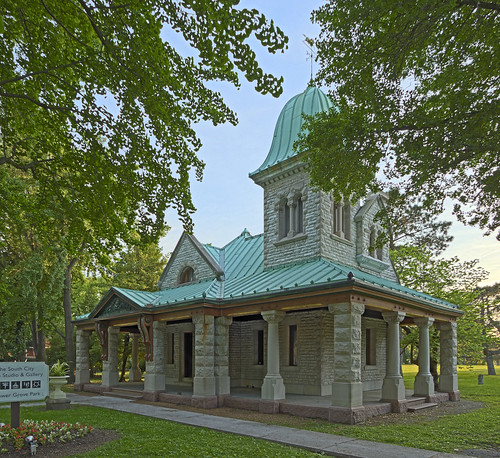
The South Gate Lodge was once the home of a gatekeeper.
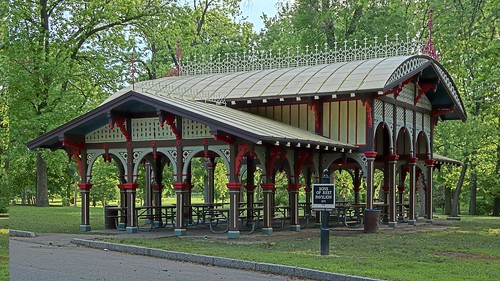
Tower Grove Park is famous for its many fanciful pavilions. This is the “Sons of Rest” pavilion, taken after a poetical name for senior citizens.
Tower Grove Park is perhaps one of the best-preserved and least-changed examples of Victorian garden design; the amount of planning and design that went into this park is nearly unrivaled by any other public park in this region.
Along with my photography, I include excerpts from a report on the park, published by its Board of Commissioners in 1883: Tower Grove Park of the City of St. Louis: Review of Its Origin and History, Plan of Improvement, Ornamental Features, Etc., By David H. MacAdam, Saint Louis (Mo.). Board of Commissioners of Tower Grove Park, Saint Louis (Mo.)
ORIGIN AND HISTORY OF TOWER GROVE PARK
The first steps toward the creation and establishment of Tower Grove Park were taken in the year 1866 although the enterprise did not assume a definite shape until the succeeding year. The Missouri Botanical Garden at Tower Grove, about four miles southwest from the business centre of the city, had been established by Mr. Henry Shaw more than twenty years before, and to this fact must be attributed the first idea of a park in that part of the suburban territory of St. Louis. The improvement of the gardens which surrounded the country home of Mr. Shaw had been carried on steadily from the commencement, and at the date mentioned although they had not attained the exquisite finish of their present condition, they formed the chief attraction in the vicinity of the city, and had acquired a national reputation for the taste and beauty they exhibited and the variety and value of their botanical features. As the gardens approached completion the conception of a large public park in the vicinity assumed a definite shape in the mind of their owner. The city possessed no ornamental pleasure grounds available for general park purposes at the time, and the need of such improvements was keenly felt, not only to supply the demands of an increasing population, but as a necessary adjunct to civic growth and reputation. The commerce and industries of the city were just reviving from the severe back set incident to the civil war, and although the desirability of park improvement was appreciated by the more thoughtful and progressive citizens, no specific enterprise had been suggested for carrying it on. Indeed the financial condition of the city, at the time, rendered it impossible for any extensive work of the kind to be paid for out of the annual revenues, nor were the tax payers prepared for a special levy to meet the cost of purchasing suburban land, then ruling at rather high rates, and the additional outlay of improving it. It was under such circumstances that Mr. Shaw matured his idea of creating a park in the immediate vicinity of Tower Grove.
Besides his own extensive travels in Europe and America, Shaw referred to a number of authorities. The full texts of representative books are linked here:
- Essays on the Picturesque, as Compared with the Sublime and the Beautiful, By Sir Uvedale Price and Humphry Repton
- Remarks on Forest Scenery, and Other Woodland Views, by William Gilpin and Thomas Dick Lauder
- A Treatise on the Theory and Practice of Landscape Gardening, by Andrew Jackson Downing
- The Parks, Promenades, & Gardens of Paris, by William Robinson
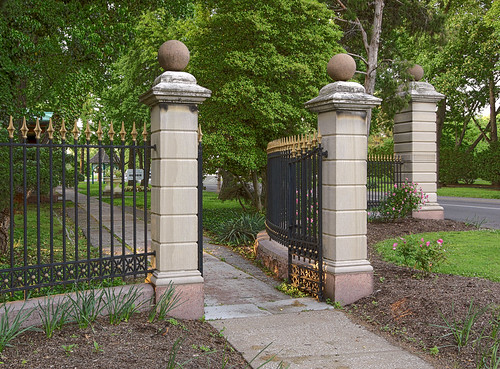
Pedestrian entrance, off Arsenal Street.
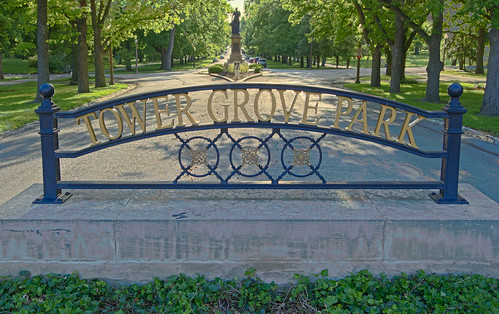
This entrance sign, off of Grand Avenue, is fairly recent.
THE GENERAL OBJECTS HELD IN VIEW
In all ornamental improvements of land the landscape gardener should keep steadily in view the purposes which the improvements are intended to subserve, and auxilliary to this, the most picturesque and economical use of the natural advantages of surface and situation. In the improvement of a public pleasure ground, the plan should be specially framed to afford recreation to the greatest number, within, of course, the proper limitations of such an enterprise. A park is not created for the benefit of any particular class but for the enjoyment of all classes — for the use of the city population in the aggregate. The spirit and motive of the improvement are unselfish and impartial, and represent the principles of practical philanthropy because they merge all social distinctions in the paramount consideration of the public welfare. The rich, the poor, the educated and the illiterate have an equal title to the fair domain of shade and sward, of pleasant walks and landscapes, all that is required of any of them being a due regard to the character of the place and the rights of each visitor It exists for the enjoyment of all — shedding its sweet influences indifferently, like the rain and sunshine, from which it gathers its foliage, fragrance and colors, and the tax payer has no pre-emptive right in any of its features over the man who never owned anything to pay taxes upon. Its broad and level drives are made for the costly chariot flashing with silver and polish, and also for the humble wagon with its painted sign indicating its daily use. There also are quiet, shady walks, specially intended for those who can command no vehicle but the street car, and who seek the park on a Sunday afternoon for a taste of that life-giving freshness and sweetness of nature without which we all languish and fade as flowers deprived of water, or as plants in a darksome room. There are seats too in pleasant places, if not for all, at least for many ; the first comer having the preference, and nature's green velvet is spread illimitably for those who choose to recline. The worrying command, “keep off the grass,” when the feet are aching to tread the carpet of youth's memories, does not harass the visitor by springing out on his eye as he turns each curve. Music, too, is thrown in free in summer time, and thus all elements of pleasure and beauty are woven together in lightness and brightness for the general good. It is on the fact of this freedom in the use of a public park, the hopefulness it indicates in human nature, and the equal consideration it shows for all classes, is based the faith of those who believe in its refining and elevating influence. Such a place does not sermonize dogmatically nor does nature. She exhibits a truth instead of voicing a doctrine. It unfolds fair spectacles, without restraint or an air of patronage, for all who care to see, and it thus tends to refute the selfish theories of either extremes of society, to reconcile divergent elements, to encourage the gentler ideas and tastes, and to promote innocent recreations and purer manners. The poor are forced to see that wealth beyond their control, and without their asking, has created a resort, free for the enjoyment of all, and the rich, by the equality in its use, are reminded of the artificial origin of class and the everlasting kinship of man.
I must note that this is an urban park, in a city that is notorious for its high crime rate. While prudence may be needed when visiting, it is usually quite pleasant. Many will enjoy the opportunities for people-watching, as well as the beauty of nature and classical art.
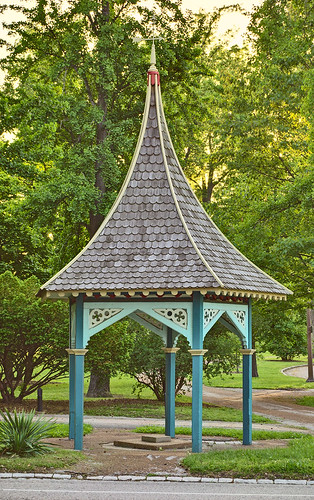
Before the introduction of drinking fountains, numerous wells provided drinking water to visitors. This decorative house covers a now-capped-off well.
Public buildings and monuments of all kinds change with changing generations and wither under the breath of time, but as long as the city endures the park will retain its loveliness. All it requires is a reasonable care to preserve its original harmony, for the elements, the seasons guarantee a perennial freshness. Each spring and summer will add new charms to the living landscapes, tremulous with fresh breezes and bright hues, and a deeper quiet to sequestered glades. Nature expresses her approval of parks by annually renewing their beauties ; always silently working to perpetuate their existence, to supplement the conceptions of Art ; repainting them with pigments drawn from sunlight, soil and air, and giving them a riper beauty with revolving years.
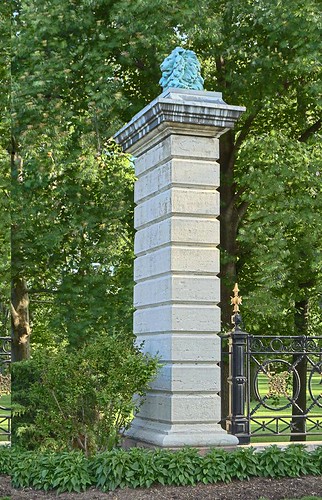
A lion sculpture, modeled after Canova, sits at the eastern vehicular entrance.
The park was specifically designed as a driving park; that is, being convenient for horse and buggy; this consideration means that it is now also well-suited for the automobile. But it was also designed so that pedestrians and vehicles would not meet, thereby avoiding accidents.
THE PLAN OF THE PARK
The shape of Tower Grove Park is that of an oblong figure, with the length many times greater than the width. From the main entrance, or east gate, on Grand avenue, to the west gate on King's highway, the distance is nearly a mile and a half.... The form of the land composing the park naturally suggested a central drive, or roadway, which was accordingly laid out with a width of nearly fifty feet, constructed carefully on a modification of the Telford plan, and each end of this drive being elevated affords a commanding view of the park. To avoid the monotony of a straight line over a mile long, there are two turn-outs, or circular spaces, which interrupt the course of the central drive, around which it branches right and left in curving roadways which unite beyond, and the stretch of grass, ornamented with evergreens and other trees, enclosed, adds a pleasing variety to the view extending westward from the east entrance....
There are also grass walks, always trimmed, and soft and rich in “grateful shade,” and terminating at some pleasant spot “lonesome cool and green,” or a circular plot where upon a pedestal stands a vase or urn, or some other pleasing feature. These walks commence at the gates for pedestrians on either side of the main entrance on Grand avenue, connecting also with the side entrances, and are continued from one end of the park to the other, without the necessity—except at one place—of crossing the carriage roads. A visitor to the park on foot, from whatever side he may approach it, will find walks leading him to all points of interest, without interruption or danger from the horses and carriages on the main roadways.
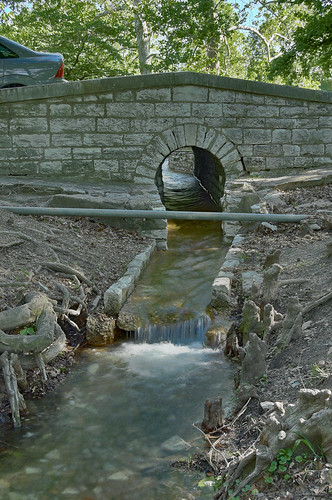
The drainage of the park is mainly from south to north owing to natural undulations, and the two most important runs are crossed by all east and west drives and walks, which are carried over on stone culverts with ornamental walls and copings ; the stonework is substantial and tasteful, and the trim gray walls show agreeably through the green foliage. The more important drives and walks are bordered by stone gutters, carefully constructed and kept free from grass and weeds, the sward being cut evenly along the edges.
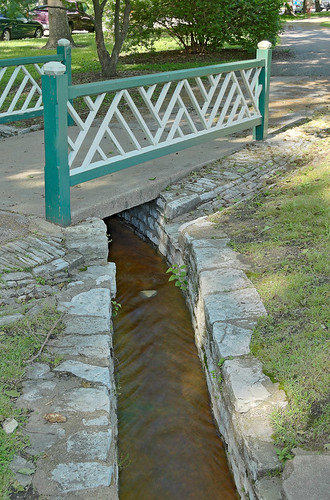
THE STYLE OF ORNAMENTATION AND REASONS FOR ITS ADOPTION
In considering the style of ornamentation adopted in the improvement of Tower Grove Park, it should be remembered that it was selected because deemed best suited to the extent and character of the ground. The picturesque, or strictly natural style, could not have been followed successfully, as it requires great distances, ancient woods, water, and other features, that were not available. Indeed, this style is not often illustrated by creations of art, except among the landscape paintings of a few great masters ; and here it is largely ideal, imaginative genius devising a type of wild nature decorated by art that it would be difficult to find among really existing scenes. Perhaps the nearest approach to it in improved grounds may be seen in some of the royal parks in the vicinity of London—Windsor, Hampton Court and Burley, Epping Forest, or the Bois de Boulogne in the suburbs of Paris. But in these historical and famous pleasure-grounds the work of art has been supplemented by the influence of time—the seasons, working through ages, creating vistas and forest shapes beyond the power of taste and skill to imitate. Evidently such effects should not control the ideas of a landscape gardener, charged with the improvement of an ordinary city park ; for he cannot possibly avail himself of the features necessary to produce them he is required to adopt a plan which can be developed within a few years, and the limitations existing as to time, money and space forbid him attempting to follow the more ancient and massive models. The task before him is to create, in a brief period, an ornamental pleasure ground, combining variety and beauty ; and as he cannot command the presence of mountain, river and forest, and other striking natural features, he is necessarily compelled to modify the picturesque style by artistic conceptions and arrangements. This modification constitutes what is known as the gardenesque or cultivated style ; and, after careful consideration, it was selected to control the improvement of Tower Grove Park, as best adapted to the treatment of an oblong shaped piece of ground, embracing less than three hundred acres of fertile prairie, possessing no remarkable characteristics.
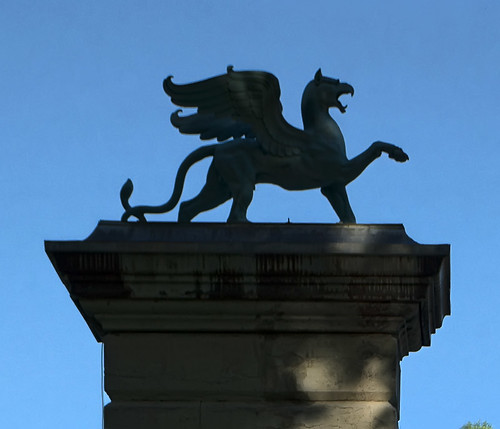
Statue of a griffin, or gryphon, a mythological beast, at the Grand Avenue entrance.

Pedestrian gate, at the northwestern corner of the park.
The cultivated style of park ornamentation necessarily implies order, systematic arrangement, but is not limited to formal or purely artistic conceptions, and the freedom and grace of nature are not sacrificed in the landscapes it creates. It offers this great advantage, that in combinations of form and color it is quite unlimited, and by contrasts in foliage and perspectives shown through sylvan openings, can group many pleasing and varied effects within really short distances. The landscape gardener, working after this style, has every opportunity of producing the beautiful, which according to Burke, is reducible to two elements, form and color, and is best expressed by scenes “comparatively small,” and possessing “smoothness” — the grandly irregular and the vast falling within the province of the sublime. He may create park landscapes of the most pleasing variety, at the same time avoiding the stiff formality of what has been called the geometric style, once so popular in Europe, and illustrated in the Versailles Garden of Louis XIV. Curious designs and angular forms in ground-work, in clipped hedges and trees, may be interesting, but their outlines can never be free and natural.

Bull Pen Gate, in the form of a Greek temple.
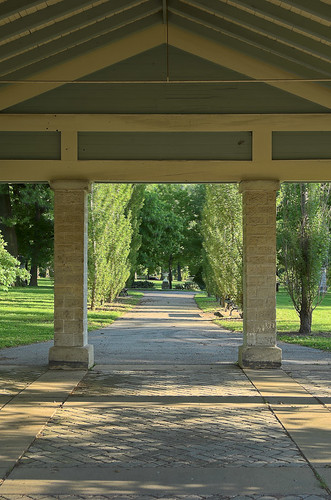
A view into the park from underneath the Bull Pen Gate.
The artist of the graceful and cultivated style pursues, then, a middle course between the picturesque and the formality of the purely artificial, aiming always to preserve the harmony of natural forms and scenes. His work is one of arrangement and selection, and without resort to unique or curious conceptions, his opportunities for combination and the creation of free and beautiful scenes are as infinite as Nature herself. Ground-work may be diversified almost endlessly by knoll and hollow, level stretches, curving lines, also by walks, drives and the introduction of water. In planting, the deciduous and evergreen trees afford a boundless variety in form and color, and to all this may be added the features arising from the use of purely artificial objects, summer houses, rustic bowers, music stands, etc., to say nothing of works of art, statues, busts, vases, etc. The varying hues of trees at different seasons may also be considered in creating landscape effects, and from numerous shades of green and livelier tints, silver, yellow, scarlet and crimson dyes, he may weave many sylvan embroideries, rare and brilliant. The variety in the shades and shapes of trees is in itself quite limitless. In his excellent work on “Suburban Home Grounds,” Mr. Scott remarks in this connection, that if the illimitable varieties of expression in human faces are produced from the changes and combinations of only half a dozen features, it is difficult to conceive the endless variety of character that may be exhibited among trees with their multitude of features and forms. This style of park improvement embraces, therefore, unbounded liberality of materials and opportunities for ornamental designs. It does not aim “to reproduce the rudeness of nature, but to adapt her to our civilized necessities, to idealize and improve, to condense and appropriate her beauties, to eliminate the dross from her vegetable jewels, and give them worthy setting.”
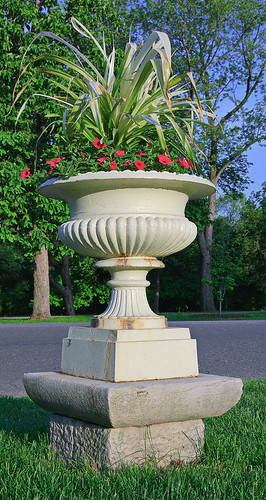
Classically-styled planter.
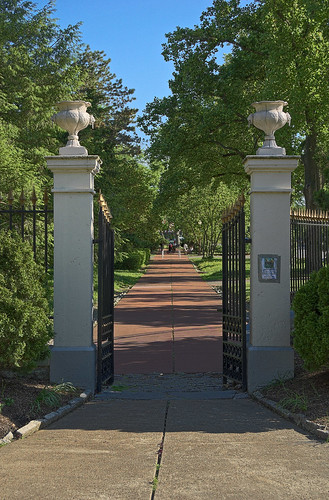
Pedestrian gate on Magnolia Avenue.
A park exists for public recreation, but the entertainment it provides is mainly for that precious sense so taxed and wearied by metropolitan life—that sense of which it has been exquisitely said: “ The sight is the most delightful of all our senses. It fills the mind with the largest variety of ideas, converses with its Object at the greatest distance, and continues the longest in action without being tired or satiated with its proper enjoyments. A beautiful prospect delights the soul as much as a demonstration, and a description in Homer has charmed more readers than a chapter in Aristotle. We are struck, we know not how, with the symmetry of anything we see, and immediately assent to the beauty of an object without inquiring into the particular causes and occasions of it.”
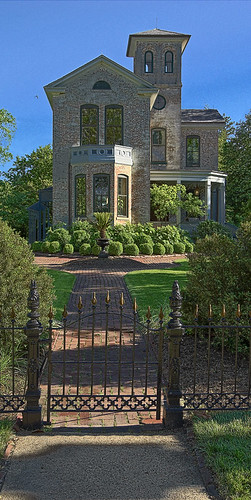
Park Superintendent's residence, located adjacent to the north driving gate on Magnolia Avenue.
It is the business of the park artist to delight the eyes of the people generally, without consulting the tastes of any particular class. “A certain artist-like feeling is necessary to enable one to relish the picturesque, for this reason the many see and feel the power of beauty in her graceful flowing lines ; but it is only the imaginative few who appreciate her more free and spirited forms. There are, perhaps, a thousand who admire the smoothness, softness and flowing outlines that predominate in the lawn and pleasure ground as we usually see them, where there is one who would prefer a cottage in a highly irregular and picturesque valley, or a castle on a rocky crag, though the latter may, to certain minds, be incomparably more enchanting.” [Downing—“Landscape Gardening.”] The park landscape should captivate the eye instantly by the voiceless appealing of grace and quietude—the vision should not be required to hold argument with the scene as to its features, for they should blend in a unity of beauty, the gentleness of which disarms criticism. The eye should receive it as the ear accepts:a delight-giving sensation, needing no introduction nor explanation; unlike the grander musical effects, which demand close attention and cultivation to understand—a beauty half elusive, mysterious ; and voices or instrumentsleave us conscious of a certain obscurity in the meaning, of the attempted translation of cloud-like thoughts and tempestuous emotions. Hence, it is an error of taste to introduce abrupt and startling features or violent contrasts in a park improved according to the gardenesque style. The controlling principle is harmony, and its requirements should be visibly obeyed in every direction, in the shape of a parterre, the opening of a vista, or the outlines and color of ornamental structures.
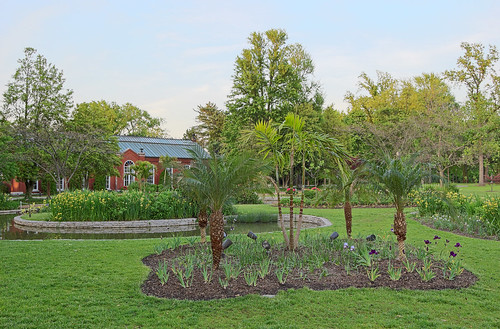
Palm trees, transplanted seasonally, near the Palm House and lilly ponds.
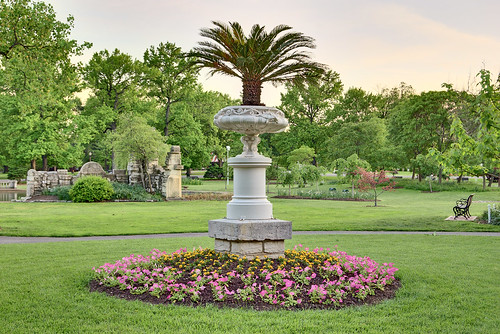
Palm, in a wrought-iron planter; “ruins” are in the background.
Lastly, it may be said, that as a park is intended to exist indefinitely, its scenes should represent a type of beauty about which there can be no controversy, but which will be always pleasing to the eye. The gardenesque style offers the best hope of accomplishing this successfully. It pleases now the greatest number, and this fact is a guarantee for the future, for tastes do not change rapidly. Burke observes that there is less difference respecting matters of taste among mankind than upon most of those which depend upon the naked reason; and Hume, in the same connection, referring to objects of beauty, says: “The same Pheidias, whose works pleased at Athens and Rome two thousand years ago, is still admired in London and Paris.”

Fountain, with geese.
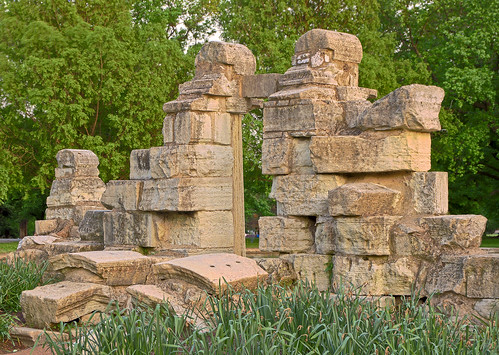
Faux ruins, constructed here from the remains of the Lindell Hotel, destroyed by fire in 1867. Click here for another view of these ruins.
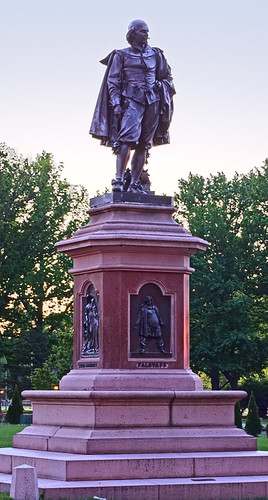
Statue of William Shakespeare is located in the center of the park. This photo taken around sunset.
It was a happy idea of Mr. Shaw to put no other inscription on the magnificent bronze in Tower Grove Park than the simple line— “He was not of an age, but for all time.” To our mind, the sum total of the critical praise which has been lavished upon Shakespeare does not equal in depth and felicity of meaning these ten little words from Ben Jonson. They are at once the tribute of a loving friend and the deliberate verdict of an impartial and perfectly competent critic. That they were written by a contemporary and survivor of him whose glory they help to perpetuate is a proof of Jonson's wonderful accuracy of judgment; a judgment which has been so thoroughly verified that it seems almost miraculous. And, as if to convince posterity that it was not a mere chance shot, but carefully matured opinion which the future must and would verify, he says elsewhere in the same poem :“Soul of the age!Not less fortunate than its legend is the location of our statue. It stands just where Shakespeare would have wished ; away from the throng and noise and dust of a great city, in the midst of a quiet scene of rural loveliness where the simplicity of nature has been tempered by the refinements of art; and where art and nature, locked as it were in a fond embrace, look abroad over the growing empire of a mighty metropolis. [quoting Mr. Thomas Dimmock]
The applause! delight! the wonder of our stage!
My Shakespeare, rise! I will not lodge thee by
Chaucer or Spenser, or bid Beaumont lie
A little further to make thee a room.”
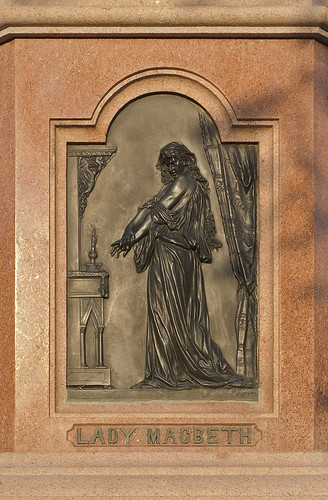
The character of Lady Macbeth from the “Scottish Play” is on the back of the Shakespeare statue's base. Here it shows the guilty Lady, sleepwalking, and attempting to wash imagined blood from her hands: this is a study of the psychology of damnation.
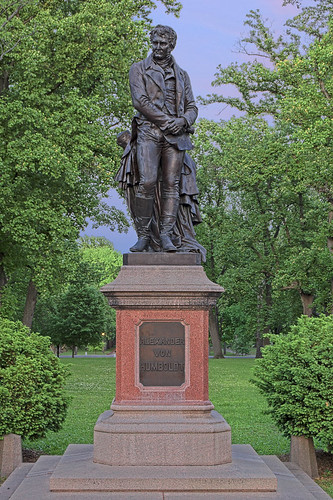
Statue of Alexander von Humboldt, explorer, botanist, and man of the Enlightenment.
Germans led the festivities surrounding the unveiling of this statue, with participation of the City's many turnvereins and other societies.
In the statue of Shakespeare, the genius of poetry and the drama is honored, and in that of Humboldt, the intellect, courage and industry of the Philosopher and Scientific Explorer. The one advances culture, develops and refines taste, and provides rational and instructive amusement—the other roams the globe in search of those truths of nature by which the boundaries of civilization and science are extended...
The statue is also the work of Mr. F. Miller, of Munich, and has a prominent site, somewhat less elevated than that of Shakespeare, but on the main drive, and quite near the concourse and music stand. It stands upon a pedestal and base of Missouri red granite, designed by Mr. George I. Barnett, architect, of the same general character as the support of the other statue, but, not quite as large or massive.
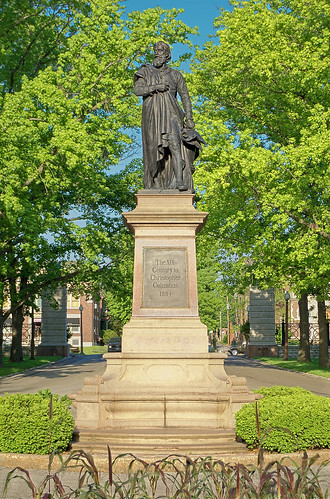
Statue of Christopher Columbus, explorer.
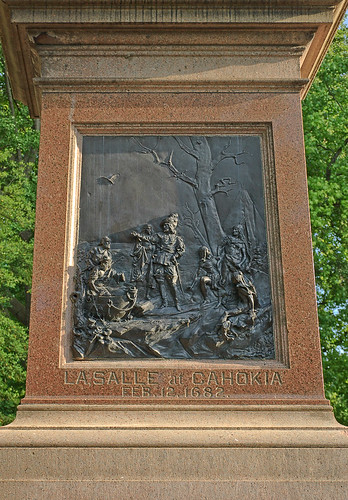
La Salle at Cahokia, Feb. 12, 1682. On the base of the Columbus statue is this plaque of René-Robert Cavelier, Sieur de La Salle, exploring the Saint Louis region.
“There is, indeed, something truly magnificent in this kind of amusement. It gives a nobler air to several parts of nature; it fills the earth with a variety of beautiful scenes, and has something in it like creation. For this reason, the pleasure of one who plants is something like that of a poet, who, as Aristotle observes, is more delighted with his productions than any other writer or artist whatever. Plantations (parks) have one advantage in them which is not to be found in most other works, as they give a pleasure of a more lasting date, and continually improve in the eye of the planter. When you have finished a building, or any other undertaking of the like nature, it immediately begins to decay on your hands; you see it brought to its utmost point of perfection, and from that time hastening to its ruin. On the contrary when you have finished your plantations (park), they are still arriving at greater degrees of perfection, as long as you live, and appear more delightful in each succeeding year than they did in the foregoing.” [quoting Addison, The Spectator, No. 583]

Pool Shelter has been repainted in its original colors. The color scheme reminds me of this recent article.
Early in April come other feathered visitants from the warmer south-lands, where instinct tells them of changing seasons far away. From the swaying tree top, we hear the clear notes of the Cardinal Redbird—and the Robin, so celebrated in song and story, is seen in the open seeking its food in the softened earth... The songbirds come to us in the opening of May, and add a new charm to the whispering of the fresh foliage.
Tower Grove Park is one of the main birdwatching areas in the region — this patch of open forest surrounded by urbanization is a magnet for birds during their migrations. Birders, who want to avoid a long trip to the Old World, visit here to see the Eurasian Tree Sparrow, which is an introduced species.
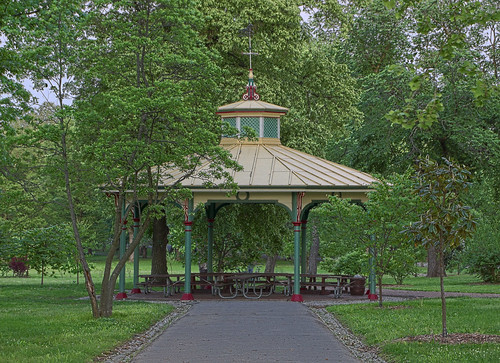
Humboldt North Pavilion. The English word 'pavilion' comes down from the Latin through Old French, meaning 'tent'.
In autumn days the glory of variegated color in a tastefully planted park becomes so striking, that the regret for the fading summer dissolves in admiration of her final scene. In such landscapes there is a greater variety in autumnal coloring, within a given space, than it is possible to find under purely natural conditions. Nature does not intermingle deciduous and evergreen trees in the harmonious combinations seen in such a place as Tower Grove Park, and this grouping of beauties usually widely scattered, illustrates the power of the landscape gardener to improve some of the aspects of her uncultivated scenes. He can intermingle maples, oaks, elms, sycamores, birches, poplars, tulip, lindens, etc., with pines, spruces, firs, cedars, larches and many other varieties of conifers and evergreens, introducing various shades of green amid the crimson, yellow, scarlet and brown of autumn leaves ripening to their fall, creating contrasts and effects as brilliant as various.
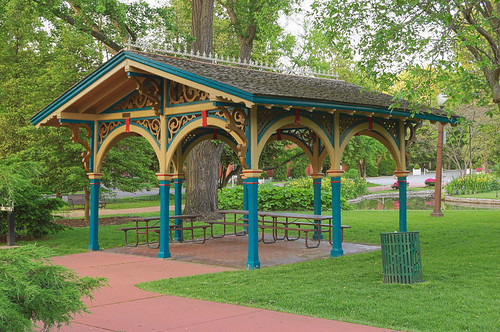
The Lily Pond Shelter.
As parks may be said to occupy somewhat the same relation to a city that private grounds do to the home of their owners, slovenliness and neglect in the care of either indicate lack of prosperity or of energy and taste. In Tower Grove, as in all pleasure grounds, the changes of the seasons bring their appropriate labors; there is no period during the year when working operations can be said to be wholly suspended, although, of course, they are reduced to the minimum in mid-winter.
By the early 1970s, after decades of city population decline, this park was in a severe state of neglect. Crime rates were high: the park was frequented by robbers, predators, and drug addicts, and so many visitors dared not leave their automobiles. Buildings and roads were hardly maintained, and the prevailing architectural style of Brutalism, with its corresponding hatred of anything before its own era, seemed to doom this park to oblivion. The ancient philosophy as described by these book excerpts, which placed the transcendental value of beauty above mere utility, was forgotten, and so beauty, and ironically even utility itself were lost. Tower Grove was becoming an ex-park.
Subsequent revival has returned the park to a close approximation to its former state. The main attraction which has been lost is the original tower which gave the park its name, as well as its adjacent hedge maze. Both have been recently replicated in the nearby Shaw's Garden: click here to see a photo; scroll down the page to view the tower or ‘Piper Observatory’.
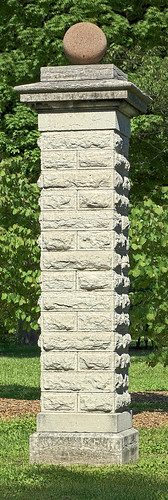

The best uses and most beautiful aspects of public pleasure grounds are confined to spring and summer; then nature makes her finest display and man has best opportunity of enjoying the pageant. As the harshness of winter dissolves in the “etherial mildness” of the season of hope and flowers, the park landscapes brighten as if pervaded by a joyous spirit. As the desolation that usually accompanies winter, in scenes of wild nature, is almost wholly avoided in improved grounds, so also, when the reign of the cold is over, such places re-assert and establish their beauty most rapidly. As the influences of refined habits, operating by insensible degrees, seem to make human faces fairer—to give a more delicate carmine, a softer texture to the skin; so, it may be said, nature's countenance becomes more sensitive, and blushes in livelier tints, when subjected to kindly culture by human hands.

Roses in bloom on the 14th of May.

...In that delightful period, when spring and summer meet and commingle their charms, when natural forms and colors have their highest grace, the skies brightest, and the air “a balmy freshness holds,” a period usually occurring towards the end of May, Tower Grove fully “dressed in living green,” appears to its best advantage. Of course, it is the time when all nature looks beautiful, whether cultivated or not, but it affords the special opportunity of the landscape gardener; then the designs he so laboriously worked out appear in their finest setting, and glow in rarest hues. These are the halcyon days for park rambles, when the resident of the city can enjoy the spectacle of nature's resurrection under the most favorable circumstances, and learn to truly appreciate the time, labor and money expended in creating the park that delights him. It is then, too, that the influence of the place co-operates most actively with that of poetry and religion, by impressing the lesson of the seasons upon minds most likely to forget it.
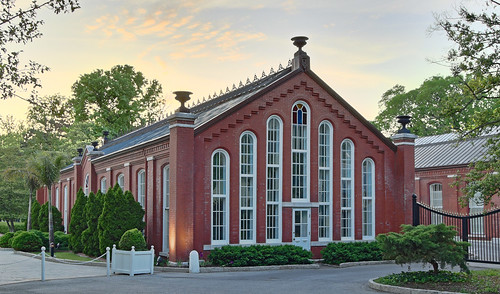
The Piper Palm House contains a café open on Sundays; it was constructed to preserve tropical plants during the winter months.
And preachers, as well as poets, have always been disposed to connect the changes of nature with human moods and feelings— to make one illustrate the other; if the bleak winds and dying vegetation of the closing autumn are “the melancholy days, the saddest of the year,” surely the keen, sweet joyance of May is the time of gladness and hope, when the sombre spirit of the winter departs and sunny ideas come to us with the birds returning from far off summer climes. Ideas that inspire not only hope, but reverence and faith towards the Almighty power that so orders the several forces of nature that winter deadness and gloom are followed by the exuberant life and brightness of spring, and suggest a like termination of human ills, when the winter of discontent will yield to happier conditions and “one universal spring encircles all.”

Music band stand, with Carrara marble busts of Mozart and Rossini.
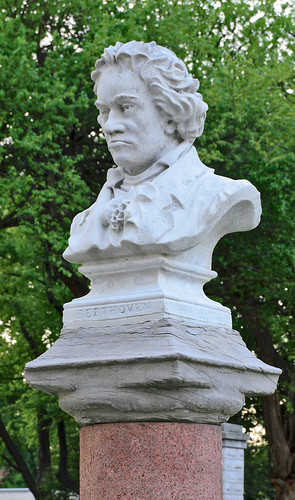
Ludwig von Beethoven.

Another view of the band stand, from the west. The roof is of Moorish design.
The origin of parks (from the French word parc or an inclosed space) is shown by Dr. Rauch to belong to remote antiquity; indeed it seems probable, that, as soon as centres of population, viz., cities, grew into existence, the necessity of open places within their limits, for the refreshment of the atmosphere and as pleasure resorts for the people, asserted its importance and suggested efforts to meet it. Christian civilization, which may now be said to dominate the world, refers the primal scene of human history to a garden—a Paradise of delights, watered by many a rill and rivers flowing in brightness, with trees of infinite variety, lawns and grottoes o'erarched with fragrant vines, and“Murmuring waters falling down the hill-slope, with banks myrtle-crowned, birds making musical the woods, and vernal air breathing the smell of field and grove.”

Humboldt South Pavilion.
But this story of a heavenly garden is not without its similitude in pagan conceptions ; the Elysium fields gleam through the golden haze of the old mythologies, and among the religious ideas of many nations scenes of perfected natural beauty are more or less connected with the origin or futurity of man. The “lotus-eater” dreams of a land where it seemed always afternoon—a land of streams and wavering lights and shadows:“The charmed sunset lingered low adown
In the red West: thro' mountain clefts the dale
Was seen far inland, and the yellow down
Bordered with palm, and many a winding vale
And meadow set with slender galingale.”
And modern as well as ancient poets draw their images of rest from sleep-soothing groves and quiet lawns where the weary may recline and dreamily behold the beauties“For ever flushing round a summer sky.”

Turkish Pavilion.
Mahomet inspired his followers by bright pictures of a paradise where beauty, animate and inanimate, rewards the world-wearied soul. The basis of these strange and splendid traditions is the ineradicable love of man for nature and her landscapes. He finds himself inseparably bound to her ; her fertility is his existence— her freshness is his health—parks, gardens, represent his desire to preserve her beauties amid the exigencies of metropolitan life.
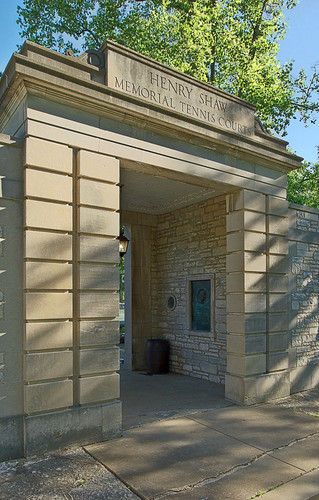
Henry Shaw Memorial Tennis Courts.
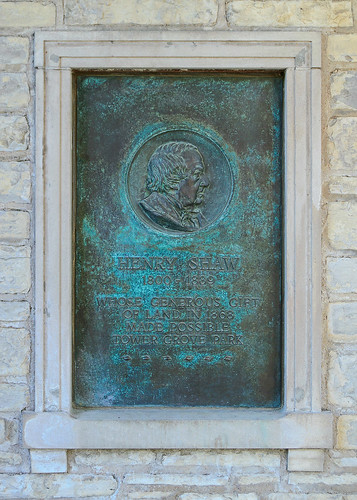
Shaw plaque.
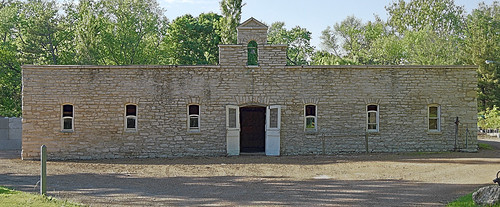
The park's horse stables.
These photos do not exhaust the visual charm of the park. Our quoted text also includes more technical sections, describing in detail the flora and fauna found here, so I encourage interested readers to either visit the park or peruse the document in more detail.


No comments:
Post a Comment